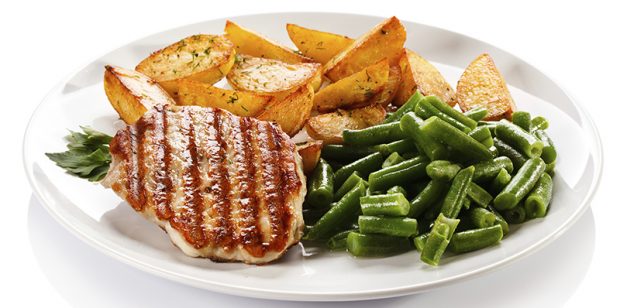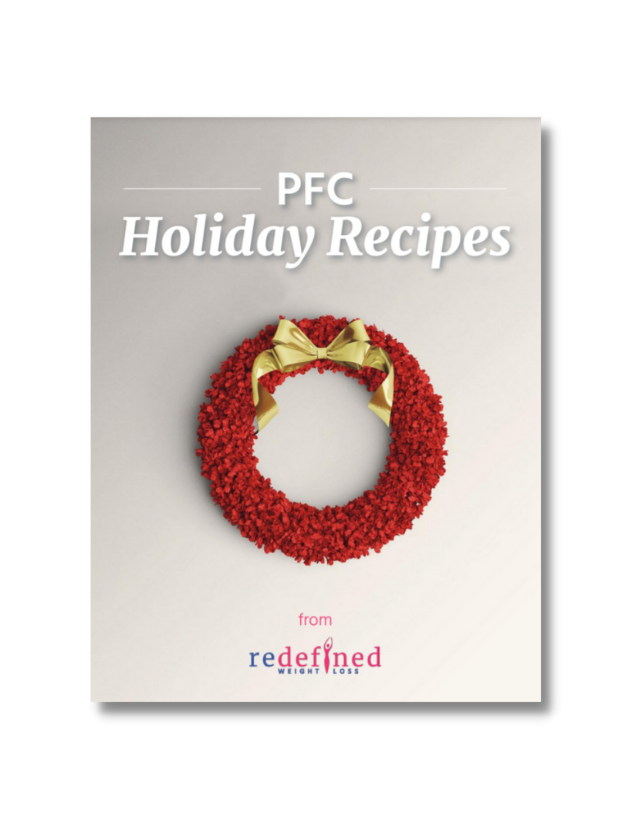Now that you know the foundation of the PFC balanced way of eating from What is PFC?, you’re probably wondering… what do I eat!? Why!? And how much?
The In’s and Out’s of Your P’s, F’s and C’s:
Protein:
The rundown: When you think of protein, think of meat, fish and eggs. I recommend animal protein because it’s the type that turbocharges metabolism the most. It also contains all of the essential amino acids in the perfect proportions, which is important for your skin, hair, heart, and hormones. Because protein has the ability to increase metabolism, it’s important to eat it throughout the day to keep energy levels up and your weight down. Protein is also an important precursor for creating neurotransmitters (brain chemicals), and if you are someone who has battled sugar, carbohydrate or alcohol cravings, then it is even more critical you make protein your new best friend in order to keep cravings at bay.
How much? A good rule of thumb is to aim for eating a portion of protein equivalent to the thickness and circumference of the palm of your hand at meals (2-3 eggs, 4-6 oz. of chicken, beef, or fish) and about half that amount for snacks. Your body does not store protein, so you need to make sure you’re eating it throughout the day—not too much and not too little. Protein at snack time can be a new concept. Most of us have protein at dinner and are lucky if we have any at lunch or breakfast. Think about incorporating protein every time you eat.
What kinds? Think animal sources of protein: meat, fish, seafood and eggs. Whey protein powder and beef protein powder count too. Keep it simple and focus on quality. Look for grass-fed, organic meats that are free of added hormones and antibiotics, free-range chicken and turkey and wild game (I love my dad’s venison!). This also means you’ll be avoiding pesticides and GMOs that are found in the feed of conventionally-raised animals, which aren’t good for your metabolism or waistline. Likewise, when it comes to seafood, buy wild-caught fish to ensure you’re not consuming heavy loads of chemical residue. Remember, anything your food ate, you’re also eating.
Not recommended: Processed meats with nitrates or MSG, meat imitation products (tofu, seitan, etc.), soy protein (Historically, soy has been glamorized as a heart healthy food, but soy protein can alter estrogen levels, decrease thyroid function, and interfere with mineral absorption), beans and other carbohydrate sources that are sometimes counted as “meat substitutes” (such as veggie burgers, many of which contain two to three times the amount of carbohydrate as they do protein, just like beans).
It is true that many foods contain protein — even some vegetables and starches, however, these plant protein sources aren’t “complete,” meaning they don’t contain all of the essential amino acids that an animal protein source would, like an egg or piece of chicken. Also, when an animal source of protein is replaced by a plant source, you end up getting a lot of extra carbs. For example, 1/2 cup of black beans (which is the serving size I recommend for starchy carbs, the category that beans fall into) contains about 20 grams of carbs and only 7 grams of (incomplete) protein. In order to get an adequate amount of protein at each meal (25 grams is the minimum for most people at meal time), you’d need to consume a cup and a half of those beans. This amounts to 70 grams of carbohydrates, which turns into 17.5 teaspoons of pure sugar the instant it hits your bloodstream! (You can figure this out with any food by dividing the grams of carbohydrate by four to get the teaspoons of sugar it turns into in your body.) Sadly, that’s a fast way to hop on that blood sugar roller coaster, which for most of us means dragging along with low energy levels, a foggy brain, sugar cravings and extra weight. As I stated earlier, the best kinds of protein are simply from meat, fish, and eggs.
F (Fat):
The rundown: Make butter your new best friend. I’m serious. Fat supports brain function, keeps us full, and acts as a buffer for carbohydrates by slowing down their assimilation into our bloodstream. Every cell in our body relies on fat because our cell membranes are made from it. It plays a central role in our nervous system, brain function, skin integrity and mineral absorption, and it has healing and immunity response properties. What you probably care about most is that it supports metabolism! That’s right: fat, which is the most calorie-dense macronutrient, is essential for long-lasting weight loss. There is a sad irony to how fat is treated in the calorie-counting community. Fat supports metabolism and actually helps us lose weight by buffering the effect of sugar on our bloodstream. Unfortunately, it is the first macronutrient to be eliminated on a calorie-counting diet simply because it has more calories per gram than the other two macronutrients. (Fat has 9 calories per gram, whereas protein and carbohydrates have 4 calories per gram.) Therefore, diets that focus on counting calories are almost always high in carbohydrates and low in fat. It’s true that if it were all about counting and restricting calories, it would make sense to eliminate fat to lose weight. However, the amount of calories you burn is controlled by your body and is dependent not just on the quantity, but also the quality of the calories you consume. Fat keeps us full and satiated. When you consume fat, a chemical called cholecystokinin is released that sends a signal to your brain, telling it that you’re full so your brain turns off your appetite. Fat helps slow the assimilation of sugar from carbohydrates into your cells, which helps to keep blood sugars stable. It also wards off cravings, aids in healthy hormone production, enhances mineral absorption and boosts healing during inflammatory processes. Fat helps lower the risk of diabetes, heart disease and obesity. Did you know that over sixty percent of your brain is made of fat? This is why your brain doesn’t work very well when you’re on a low fat diet; you’re depriving your brain of the fats it needs for basic functioning. We NEED healthy fat. Oh, and it doesn’t make you fat — if you’re eating the right kind. Remember, it’s carbohydrates that convert to sugar and then are stored as fat — NOT healthy fats.
How much? A good starting point is including two to three tablespoons of fat every single time you eat—meals, snacks, whenever. This could mean sautéing your veggies in a couple tablespoons of coconut oil at dinner and topping your salad with sliced avocado, or having a heaping spoonful of almond butter on your apple at snack time. It’s important to have a balance of PFC, but when in doubt about portion sizes, it’s usually safe to have more fat and less carbs.
Recommended Fat sources: Healthy fats are butter, coconut oil, olive oil, avocado oil, cheese, olives, coconut milk (the canned kind), heavy cream, nuts, seeds, nut and seed butters, coconut cream and fat from organic, grass-fed meat. When people recommend lean meat, it’s likely because they are assuming you don’t have access to high quality meat. If you’re getting high quality grass-fed, organic, pasture-raised meat and dairy, I recommend purchasing full fat, both because it’s the healthy kind…and because it tastes fantastic, too! Since toxins are stored in fat, you’ll avoid consuming higher levels of those toxins by choosing lean meat. You can always add good fat in the form of butter, olive oil or avocado.
Not recommended: I recommend staying away from processed fat sources and man-made oils like canola oil, corn oil, soybean oil, safflower oil, sesame seed oil, cottonseed oil, vegetable oil, shortening and margarine. Also, any oil that has been hydrogenated or partially hydrogenated is a trans fat. If you ever see any oil (even the healthy ones like olive, coconut or avocado) listed as partially hydrogenated or hydrogenated, this is a big, bright, red flag and I recommend staying away from those at all costs. Because of rancidity, oxidation (free radicals), and unhealthy refinement processes, all of these oils can cause inflammation in the body and lead to weight gain. It’s also important to keep your oils tightly covered to minimize the damaging effects oxygen has on them. Exposure to oxygen causes oils to become inflammatory. For a similar reason, store oils in a cool, dark place (i.e. no kitchen window sills!).
C (Carbohydrates):
The rundown: It may take some time and reprogramming of your brain to switch from thinking of carbs as exclusively bread, rice and pasta, and instead, to begin thinking of colorful, nutritious veggies and fruits. I encourage getting most, if not all, of your carbohydrates from veggies and fruits. Think colorful carbs! These real food carbohydrate sources provide more nutrients and antioxidants, and generally they have a far smaller impact on your blood sugar levels, giving you a bigger bang for your buck, so to speak.
Vegetables can be divided into two categories: starchy and non-starchy. Starchy vegetables like corn, peas, beets, squash, yams, sweet potatoes and plantains are denser and have a greater effect on blood sugar levels. Non-starchy vegetables like broccoli, cauliflower, cabbage, kale, peppers, green beans, cucumbers, and asparagus hardly raise your blood sugar levels, if at all. Fruit is generally on the same playing field as starchy vegetables, depending on the type of fruit. Berries and citrus fruits have less of an impact on blood sugar levels than bananas, apples, and pears.
How much? In general, sticking to a half cup of starchy vegetables or fruit is a good place to start. With non-starchy vegetables like broccoli, cauliflower, spinach and cucumbers, the portion size is pretty much unlimited since they hardly have any impact on your blood sugar levels. In fact, because they are somewhat difficult to break down, they may even require more energy to process than we even receive from them. This means we gain important nutrients without a blood sugar spike, and for that reason I suggest that you fill up on these first (shoot for a couple cups at each meal!). Limit the starchier veggies and fruit to about a half cup (or even a quarter cup) at a time to help prevent blood sugar spikes. A quarter cup may seem rigid if you’re used to snacking on fruit, but if losing weight is your goal, it’s important to minimize the sugar you’re consuming and choose non-starchy veggies for your carbs as much as possible. If you pick carbohydrates from the ones I recommend avoiding, try to stick with a half cup, or a single slice of bread to limit their impact.
Recommended Carbohydrate sources: Vegetables and fruits.
Not recommended: Grains, pasta, bread, rice, cereal, muffins, cakes, cookies, pretzels, chips and any and all other processed, refined carbohydrates which take your blood sugar levels for a roller coaster ride, contribute to inflammation, and take you further from your metabolism and weight loss goals. Reducing your consumption of sugar and processed foods is a great way to avoid the blood sugar roller coaster altogether. These are foods that have been chemically processed and made from refined ingredients.
3 Additional Questions worth answering:
1. Can a hot dog and french fries count as PFC balanced? Food quality matters and is a critical aspect of my PFC balanced eating approach that cannot be overlooked. Hot dogs and french fries could count as protein, fat and carbohydrates but when it comes to supporting your metabolism, brain function and energy levels, they will have the complete opposite effect on when compared to eggs, butter and spinach, or grass-fed hotdogs with sweet potato fries! The foundation of the balanced PFC approach to eating is REAL FOOD and I consider processed, fried foods like hot dogs and french fries to be fake food. Look for grass fed or organic meats that are free from added hormones and antibiotics. Buy wild caught fish and seafood to ensure you’re not consuming heavy loads of toxic chemical residue. Buy organic veggies and fruits — at least for the ones where you eat the skin.
That being said, I have been known every now and then to count a glass of wine (carbohydrate) and dark chocolate (fat) as a bedtime snack. Part of making lifestyle changes is learning your own limits and where you can give and take. What’s important is to make sure you know that where there is compromise, you are able to still maintain balance and overall nutrition in the rest of your diet.
2. Does portion control matter? Yes, but the good news is it’s a lot easier to regulate portion control intuitively when you’re eating real, whole foods in PFC balance, when compared to a low-fat diets full of refined, processed carbohydrates and bad fats. The best way to assess how you’re doing with your portions is to pay attention to your hunger level before every meal and snack. On a scale of 1-10, 10 being starving and 0 being stuffed, you want to be around a 5 every time you eat. If you feel too full to eat, then your portions at the previous meal or snack were too large.
Here are some things to consider when thinking about your portion sizes:
- Do you have protein, fat, and carbs on your plate?
- Is your protein about the size of the palm of your hand?
- Do you have at least 2 Tablespoons of fats on your plate?
- Are you keeping your intake of starchy vegetables or fruit at ½ cup serving and having a cup or two of non-starchy veggies?
- Are you subconsciously still cutting calories or fat? Make sure you are eating enough! Many people still have the low fat mentality when buttering their broccoli and hold back on the fats or skip meals. Unbrainwash yourself! Your metabolism doesn’t function if you don’t feed it.
- Has it been more than a few hours since you’ve eaten? If so, try a small snack while you’re preparing dinner so you don’t gorge yourself at mealtime.
- If you are eating consistently throughout the day with PFC balanced meals and snacks, your body will tell you when to stop. Real foods help normalize your body’s satiety mechanisms and prevent cravings and binge eating by keeping blood sugar levels stable throughout the day.
Examples of PFC balanced meals:
- 2-3 scrambled eggs (P) cooked in 2 Tablespoons of butter (F) + 2 cups spinach + 1/2 cup sautéed sweet potato (C)
- 1 cup of salmon salad made with 3-4 ounces wild alaskan salmon (P) + 3-4 Tablespoons full fat mayonnaise (F) + 1/2 cup chopped celery and 1/2 cup grapes (PFC)
- 4 ounces of steak strips stir fried in 2 Tablespoons of coconut oil (F) + 1-2 cups mixed vegetables (broccoli, cauliflower, celery, green beans, carrots, water chestnuts) served over 1/2 cup spaghetti squash noodles (C)
- 5 ounces of grilled chicken (P) + 1/2 avocado sliced + 1 ounces feta cheese + 1 Tablespoon sunflower seeds (F) over 3 cups of leafy greens + 1/2 diced apple + 1/2 cup halved tomatoes +1/2 cup sliced cucumbers (C)
- 4 ounce grass-fed beef burger (P) + 1 Tablespoon pumpkin seeds + 5-10 olives (F) served over 1 cup fresh greens topped with 1/2 cup mixed vegetables (tomato, cucumber) (FC) + a side of 1/2 cup cooked carrots (C)
- 6 ounces of wild alaskan salmon (P) drizzled with 2 Tablespoons of butter (F) + 1/2 sweet potato and 2 cups of spinach salad (C)
- Balanced smoothie with 1 scoop whey protein powder (P) + ¼ cup coconut milk (F) + 1 cup spinach + 1/2 cup blueberries (C)
Examples of PFC balanced snacks:
- ½ cup tuna salad made with 2 ounces white albacore tuna (P) + 2 Tablespoons olive oil (F) + ½ cup raspberries (C)
- 1-2 hard boiled eggs (P) + 2 Tablespoons nut butter (F) + ½ banana (C)
- 1-2 ounces grilled chicken (P) + 2 Tablespoons full fat cream cheese (F) + a pickle (C)
- 1/2 cup plain, full fat Greek yogurt (PF) + ½ cup blackberries (C)
- 1 ounce dried beef stick (P) + guacamole (1/2 avocado with fresh squeezed lime and diced tomatoes) (F) + 2-3 cups raw veggies (C)
- 1 deviled egg made with 1 hard boiled egg (P) + 2 Tablespoons full fat mayonnaise (F) + a clementine (C)
- 1 slice of egg bake (PFC)
For meal plans, you’ll love our 50 Days of PFC, where it’s all laid out for you so you know what to eat for 50 full days. We take away the burden of having to figure out what to eat and lay it all out in one convenient e-guide (we have one for adults, and one for kids, too!)
3. How much is right for me? Everyone is different. If you are a marathon runner you may need to eat differently than someone who is pregnant and she might need to eat differently than her two little children. Men and women require different amounts of each macronutrient, and your health goals may also dictate different ratios. The most important thing to focus on is first eating real foods and making sure you have PFC balance at each meal. Use the suggested serving sizes listed above (palm size protein, 2-4 Tablespoons of healthy fats, and 1-3 cups of non-starchy carbs with 1/2 cup of starchy carbs at each meal). If you’re trying to lose weight, you may need less carbs and more fat. If you’re pregnant, you may need more protein.
I would love to invite you to our FREE online Facebook Community, A New Way To Weight Loss! This group is all about helping helping people like you stop the vicious dieting cycle, end the obsession over food and lose weight effortlessly—while enjoying what you eat, and feeling like your happy, confident self again. This as a community where we can connect and support each other and have a conversation with you about your weight loss goals. Click here to join A New Way To Weight Loss!













Wow, Cassie… a great overview. The biggest challenge for me is the breads, rices, pasta, etc… I don’t know that I could give up those things. But, I definitely go with the least-processed whole-grain-based, organic products that I can find!
I would love more simple and easy snack ideas! At work I am usually running around and only have 2-3 min breaks where I can shove some food in my face, so convenience is key. I usually eat a granola bar or a prepackaged yogurt cup, but I know these do not follow PFC guidelines.
What cattegory would you put cottage cheese into? Sometimes I’ll throw some blueberries on there, with a handful of nuts on the side. Is this a good PFC option?
Thank you so much for this information. I’ve been a part of the “old”thinking way too long! This really helps put it all in perspective. I appreciate your viewpoint and the way you share.
How about a balanced breakfast smoothie with no yogurt? Fruit, protein powder and avocado or coconut milk. Recipe ideas here: http://www.dietitiancassie.com/balanced-smoothie/ ~ otherwise, breakfast food does not have to be breakfast food! We are the only species that thinks this way 🙂 Have a piece of meat with veggies and coconut oil 🙂
Hi Molzy! Thanks for reaching out and I understand your concerns. The good news is we have lots of experience helping with weight gain, and just preventing weight loss in general. My team and I would love to help you by providing individualized recommendations for your lifestyle and the foods you like to eat. Send us an email, [email protected] and we’ll get you set up for an appointment so we can get you on your way to reaching your goals!
Good question. I’ll address milk in PFC Part 3B, but for now know that I do not recommend it to be part of PFC balanced eating, but if you are including it, you could count it as all 3 PFC IF it’s whole (full fat) milk.
Hi Cassie, I usually have a “flax minute muffin” for breakfast (1/4 c ground flaxseed, 2 tbsp coconut milk, baking powder, cinnamon and 1 egg) I eat it with coconut spread or Manna, or add berries to the mix before baking. Would this meal be considered PFC?
For most people I don’t think that would be enough food! Depends on a lot of things of course, but for most people they need 2-3 eggs and a serving of carbohydrate at breakfast time too.
just a heads up, you can make scrambled eggs in the microwave! do it practically every day here at work. just scramble in a coffee cup (or something similar) and toss in for 30 seconds, scramble again and 30 more seconds.
Pork is fine! Like other meat, quality matters so organic grass fed is best!
Hi Cassie! What about honey being part of breakfast? My aunt has always emphasized how important it is for nutrition but is that true? Because as fas as I’m concerned it’s full of carbohydrates.
I usually say sugar is sugar is sugar.
Do you have to wait 3-4 hours before eating again after a meal. I seem to be hungry again 1 hour later. Should I increase vegetables or fat? Maybe that would help? Your thoughts please.
There is 2 components there. 1. Your body and mind is used to those times and 2 you are eating too much carbs. Have you think to get bone broth with meat and veggies for breakfast? and maybe an egg and cheese or peanut butter? you’ll do half a day or more but you need to work your body and mind little by little to get there.
Hi Cassie. Do you still need 1-2 tbsp. of fat if your protein source is particularly fatty i.e. chicken thighs with skin or smoked mackerel fillets? Many thanks, Emma
If it’s a fatty source of meat, then you don’t *need* it, but I always think it’s best to veer on the side of more fat than not enough (and less carbs than too many). That’s my 2 cents 🙂
Hi Cassie,nDo you think a person can get off prescribed meds if they take your recommended supplements? I feels like I’m in a viscous cycle from reflux, gallstones and prescribed Prilosec having a growing abdominal girth, bloating, stomach aches, weight gain.
Hi Jj! Good question. It really depends on a lot of things, but I can tell you that the way we treat the symptoms you are describing is very different than the conventional way. Prilosec acts as a band-aid. We address the root cause and heal from within. For more info, please contact our team! We’d love to talk to you about how we can help! http://www.dietitiancassie.com/contactdc/
Good choise but include 50% the amount of good fat you eat in Omega 3. So if you eat 20grs in fat from nuts, make sure you eat 10grs of Omega 3.
Hi Cassie,nnnThere are times that I feel the need to eat smth sweet. What would you recommend me to eat on these occasions?nnnRegards
Hi Arthur! We recommend always eating the combination of PFC to help stabilize blood sugars! So even if you want something sweet, if it’s a sweet carb like a glass of wine, balance it out with some healthy fat and protein, like cheese and slices of meat!
I think raisins are fine, but keep in mind that since they are dried grapes, about 2 Tbsp is equivalent to 1/2 cup serving of grapes (I’d rather eat the fresh fruit!). That said, they’re a great portable carbohydrate u2014 just make sure there’s no added sugar (they frequently sweeten craisins with added sugar).
Mushrooms are great and we would consider them a carbohydrate. We also count quinoa as a carbohydrate (we cover that under the 2nd bullet here: http://healthysimplelife.com/pfc-balanced-eating-part-3b-faq/) and chia and flax seeds are *bonus* healthy fats!
Hi Lisa! Good question. Beans are mostly carbohydrates anyway, so we wouldn’t recommend those as a protein source. It can certainly be tricky to get in enough quality protein without most animal products and I”m unable to provide individualized recommendations outside of a coaching appointment. I’d encourage you to set one up so that we can help your son be the healthiest he can be! 🙂 [email protected]
-Cassie
What about skinny chips (flax seed based crackers, with no wheat) fit in the scheme of this plan?
Sure! Anything really fits into this plan, as it’s a general template with the goal being to customize to help you reach your goals, whatever they may be! 🙂
When I make suggestions for fat, I am referring to added fat, so yes—I would recommend counting bacon as a protein and add a fat! 🙂
Yes, we believe in keeping the carbohydrate focus on real, whole food carbohydrates as much as possible (veggies and fruits) and avoiding gluten which interferes with nutrient absorption. We don’t recommend grains since all grains, whole or not, are processed. Of course it is completely up to you what you choose to eat! Homemade is likely better, but also keep in mind those types of carbohydrates turn into a lot of sugar in the body (usually around 6 teaspoons per slice). If I were to eat a slice of bread, I’d choose gluten free to avoid anti-nutrients, and for the most part I keep my focus on carbs from real food!